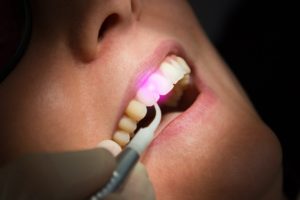 If your periodontist recently recommended crown lengthening, you might have been a little surprised. Why would you need an additional procedure to treat a cavity or to get a crown? Believe it or not, it’s a common treatment used for both restorative and cosmetic reasons. While you may not feel the minor surgical procedure is necessary, here are 4 reasons you might want to take your periodontist’s advice.
If your periodontist recently recommended crown lengthening, you might have been a little surprised. Why would you need an additional procedure to treat a cavity or to get a crown? Believe it or not, it’s a common treatment used for both restorative and cosmetic reasons. While you may not feel the minor surgical procedure is necessary, here are 4 reasons you might want to take your periodontist’s advice.
1. The Tooth is Too Short
Crown lengthening removes or reshapes gum tissue to reveal more of the tooth surface. Your gums need at least 2mm of the tooth surface to create a seal. The bond is necessary to prevent food particles and bacteria from causing dental problems, like gum disease.
A tooth can be too short for multiple reasons, such as severe decay, a significant break, or genetics. Not only is the size of the tooth important for your gum health but also for restorations. There must be enough of the tooth exposed to support certain restorations, like veneers, crowns, or bridges.
2. Decay Below the Gum Line
Cavities can occur anywhere on a tooth, not just the crown. If decay is found below the gum line, crown lengthening can reduce the tissue level to have better access to the cavity. As a result, your dentist can properly treat the decay to preserve your tooth.
3. Resolve a Gummy Smile
A gummy smile can be embarrassing. When the gums are visible above the teeth when smiling, crown lengthening will remove the excess tissue to make the surfaces of the teeth larger. Not only does this improve the aesthetics of your smile, but it can also reduce your risk of gum disease, which is the leading cause of tooth loss.
4. Better Fitting Restoration
Your tooth acts as an anchor for certain restorations, like crowns or veneers. Reshaping the gum tissue can ensure a better fitting restoration to enhance comfort and oral hygiene. This can be the case when a tooth is severely broken or decayed.
Enhance Your Smile with Crown Lengthening
If you need crown lengthening, don’t worry about scalpels or sutures. Dental lasers have transformed the procedure to make it less invasive while adding unmatched precision. A highly concentrated beam of light energy targets the tissue with pinpoint accuracy. The laser sterilizes and cauterizes the tissue as it is removed, lessening the risk of postoperative complications, like inflammation, bleeding, and infections.
Your gum may be a little tender for a couple of days, but you can manage it with ibuprofen. Your periodontist will recommend eating softer foods for a few days to avoid irritating the healing tissue. After 1-2 weeks, you’ll be recovered completely and ready to share your smile with the world.
About Dr. Rob Wood
Dr. Wood earned his dental degree from the Temple University Kornberg School of Dentistry before continuing his periodontic training at the University of Texas. He is a board-certified periodontist and a member of various professional organizations, including the American Dental Association. If you need crown lengthening, contact our office today to schedule your consultation.
